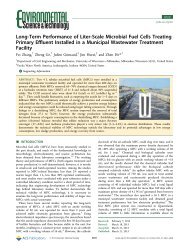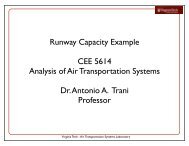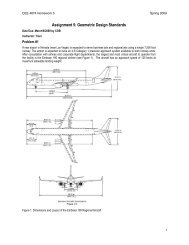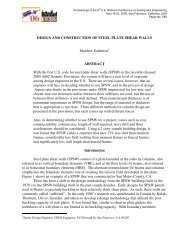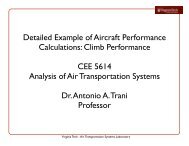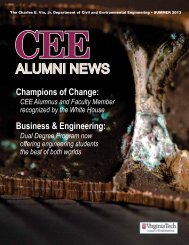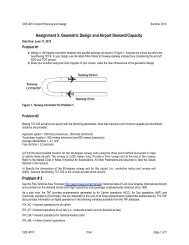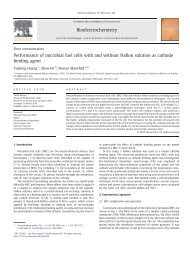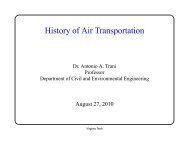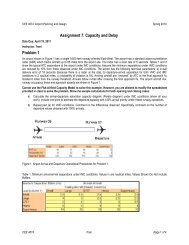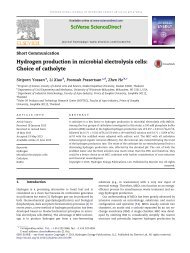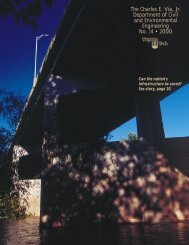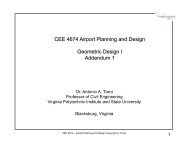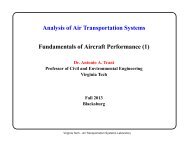PROGRAM AREAS: GEOTECHNICALinterfaces. With Panos Diplas, a project funded by the Officeof Naval Research on channeling in young marine sedimentswas completed.Gutierrez was invited to give lectures at the first U.S.-Japan Workshop on Testing, Modeling, <strong>and</strong> Simulation inGeomechanics, in Boston, Mass., the Chalk GeomechanicsWorkshop in Stavanger, Norway, <strong>and</strong> the 2003 GeopierConference, in Alex<strong>and</strong>ria, Va. He was also invited to give alecture to the Chilean Geotechnical Society (at the Universityof Chile). Gutierrez continues to serve as editorial boardmember of the ASCE Journal of Geotechnical <strong>and</strong>Geoenvironmental <strong>Engineering</strong> <strong>and</strong> as a member of ASCE<strong>and</strong> ASME committees. He was awarded an Outst<strong>and</strong>ingAlumnus award by Saint Mary’s University (Philippines).A significant portion of Jimmy Martin’s year involvedworking with colleagues to establish the Center for ExtremeLoad Effects on Structures (CELES), which is described onpage 6. In addition to co-directing CELES, Martin continuedhis earthquake engineering research, with funding from theNSF <strong>and</strong> other agencies. His NSF work involved soil <strong>and</strong> siteimprovement for mitigation of earthquake-related damages,<strong>and</strong> he traveled to Taiwan to participate in an NSF-sponsoredworkshop there.He developed new proposals to NSF <strong>and</strong> the Washington,D.C. Department of Transportation (DDOT). He served as coauthorof a $10 million NSF proposal submitted to NSF’sAlliances for Graduate Education <strong>and</strong> the Professoriate(AGEP) Grant. The AGEP program is designed to increase thenumbers of underrepresented doctoral students pursuing academiccareers in science <strong>and</strong> engineering. Martin served asprincipal investigator for a proposal to DDOT to perform adetailed earthquake hazard <strong>and</strong> terrorist-attack vulnerabilitystudy of the D.C. bridge system, <strong>and</strong> to develop an automatedGIS database that can be used in emergency responseoperations. The GIS database will allow rapid assessment <strong>and</strong>graphical display of the impact of different earthquake <strong>and</strong>terrorist event scenarios.Martin completed Earthquake Hazard Management, a university-levelhigher education course for FEMA’s HigherEducation Project/Dept. of Homel<strong>and</strong> Security <strong>and</strong> sponsoredby ASCE. The course is for worldwide distribution <strong>and</strong> is currentlybeing published. The document was rigorouslyreviewed as a textbook, taking three years to complete <strong>and</strong>consisting of more than 1000 pages of text. He also participatedin professional engineering shortcourses <strong>and</strong> seminars<strong>and</strong>consulted on projects including the Surry Nuclear PowerStation <strong>and</strong> the Charleston, S.C. tunnel project.Matthew Mauldon participated in the newly-fundedAMADEUS project <strong>and</strong> in the multi-disciplinary Virginia TechDUSEL initiative. These projects involved collaborations withGutierrez, Dove <strong>and</strong> other faculty, as well as with JasonShelton, Via Scholar Jeramy Decker, Mike Hasek, <strong>and</strong> severalother graduate students. With Tom Br<strong>and</strong>on <strong>and</strong> MarkOsowski, Mauldon began work on a laboratory study todetermine swell pressures arising from oxidation of pyriticshale. Along with Brett Rose, Sam Cain <strong>and</strong> Aaron Antell,Mauldon continues work on development of a turn-key GISbased,web-enabled management system for rockfall hazardon roads throughout the state of Tennessee (funded byTennessee DOT). With Xiaohai Wang, he is investigating theutilization of fracture trace data from cylindrical samples (i.e.,borehole or tunnel walls) for characterizing fractured rockmasses. Wang’s presentation of this work tied for best posterat the North American Rock Mechanics Symposium in24Houston. Mauldon <strong>and</strong> Wang also made three presentationsto ExxonMobil on aspects of this work.Mauldon completed a stint on the editorial board of<strong>Environmental</strong> <strong>and</strong> <strong>Engineering</strong> Geoscience <strong>and</strong> continueson the editorial board of Rock Mechanics <strong>and</strong> Rock<strong>Engineering</strong>. He chairs the ASCE Rock Mechanics committee,<strong>and</strong> serves on ASCE’s committee on engineering geology <strong>and</strong>site characterization. He coordinated the CEE Department’sCEUT teaching group (CCTeg) this year, which culminated ina focus group meeting held with Virginia Tech’s ASCE studentchapter <strong>and</strong> targeted towards student perceptions of teaching.Mauldon serves as coordinator of the geotechnical engineeringprogram area.Jim Mitchell, although officially retired, continues to contributeto the program. In addition to presenting seminars, heremains active in research, including the project on rapid stabilizationof cohesive soils using admixtures described above,a study of better definition of the range of applicability <strong>and</strong>enhancement of deep dynamic compaction (DDC) in finergrained soils, <strong>and</strong>, with Ph.D. student Ning Liu, the limitationsof shear wave velocity as an indicator of the liquefactionpotential of silty soils, shear wave velocity–cone penetrationresistance correlations, <strong>and</strong> the usefulness of soil specific surfacearea as a reliable measure soil engineering properties.With co-author Kenichi Soga, a reader at CambridgeUniversity, Mitchell is working to complete the third editionof Fundamentals of Soil Behavior, for publication for the2005-2006 academic year. With Rick Mitchell. he prepared astate-of-the-art-<strong>and</strong>-practice paper, “<strong>Environmental</strong> Geotechnics;Two Case Histories” for the Fifth InternationalConference on Case Histories in New York City in April. Heis to present the Nabor Carrillo Lecture of the MexicanGeotechnical Society in Guadalajara in November. The titlechosen for this presentation is “Time, the Fourth Dimensionof the <strong>Engineering</strong> Behavior of Soils.”Mitchell’s consulting activities included studies ofground improvement for seismic risk mitigation at dams inBritish Columbia, California, <strong>and</strong> North Carolina; stabilityreview of large mine waste rock piles in New Mexico; <strong>and</strong>analysis of the probable performance of large LNG tanks supportedby stone columns in soft estuarine deposits at the Portof Long Beach, Calif. He serves as chair of the civil engineeringsection of the National Academy of <strong>Engineering</strong>.
Structural<strong>Engineering</strong> & MaterialsThe quest for better bridges: CEE researchers areinvolved throughout the region in prototype bridge projectsthat use designs <strong>and</strong> technology developed at VirginiaTech. Some of the concepts being tested include pre-castbridge deck panels, glass fiber reinforced polymer reinforcementbars (GFRP), bulb-T girders, <strong>and</strong> ultra-high performanceconcrete. Pictured at top is live-load testing byCarin Roberts-Wollman’s team of the Sugar Grove, Va.Route 601 bridge, which uses GFRP for low maintenance<strong>and</strong> longer life. Shown above is a historically significantCovington, Va. through truss bridge, which will be rehabilitatednext summer. The bridge will use lightweight fiberreinforcedpolymer (FRP) decking, which is one-third theweight of a reinforced concrete deck, so that emergencyvehicles can use the bridge.Faculty members in Structural <strong>Engineering</strong> <strong>and</strong>Materials continued to excel in a number of education<strong>and</strong> research areas as listed below. Many ofthese accomplishments would not be possible withoutthe dedicated support of the students <strong>and</strong> staff.Virtual work as structural behavior toolFinley Charney has continued his efforts in research relatedto earthquake engineering, structural dynamics, <strong>and</strong> structuralsoftware development. Within the field of earthquakeengineering, he is focusing on the development of analyticaltools to identify <strong>and</strong> control sources of systemic dispersion instructures. He is also continuing his research activities in theapplication of virtual work as a tool for structural behavioridentification <strong>and</strong> optimization.Together with James Martin <strong>and</strong> other faculty, Charney hascreated a new center called the Center for Extreme LoadEffects on Structures (CELES). The main purpose of the centeris to reduce economic loss <strong>and</strong> human suffering from extremeloading <strong>and</strong> operates under the umbrella of the Institute forCritical Technology <strong>and</strong> Applied Science (See article, page 6.).With funding from an industrial sponsor, Charney managedthe development of a new finite element analysis“engine,” programmed in object-oriented C++. This programwill be used as the platform for incorporating more advancedanalysis capabilities including nonlinear dynamic analysis,incremental dynamic analysis, probabilistic analysis, <strong>and</strong>graphical visualization. Porting of the software to VirginiaTech’s new supercomputer is under consideration.The educational computer programs NONLIN <strong>and</strong>EQTools were recently upgraded through funding from theNational Institute for Building Science. These programs wereused in a new graduate-level course in earthquake engineeringthat was co-taught by Charney, Sam Easterling, <strong>and</strong> CarinRoberts-Wollmann.Charney continues to be active in technical committees,chairing both the ASCE committee on Methods of Analysis,<strong>and</strong> the ASCE Structural Congress Committee.Blast loads on tentsRay Plaut <strong>and</strong> Rakesh Kapania of aerospace <strong>and</strong> oceanengineering finished a one-year grant from the Air ForceResearch Laboratory involving a finite element analysis of thedynamic response of tents to blast loads. Also, tests were conductedon the material of the outer canvas <strong>and</strong> on the innerliner, which is supposed to prevent personnel from externalchemical <strong>and</strong> biological agents.Plaut continued to investigate the potential application ofslack ropes for mitigation of the seismic response of structures.A portal frame has been designed <strong>and</strong> will be testedunder periodic loading in the structures laboratory. Later, a25



